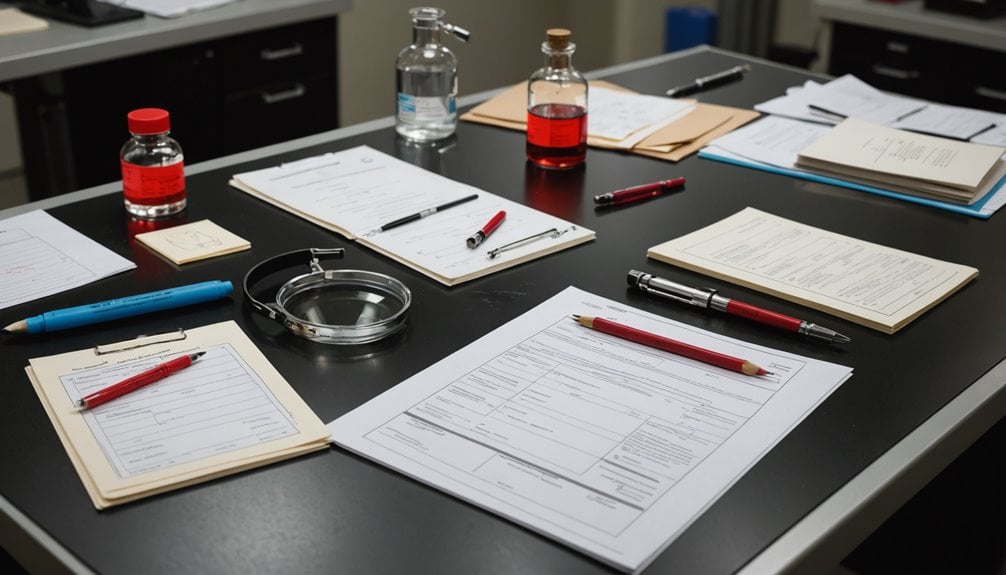To write an effective pharmaceutical deviation report, you'll need to follow a structured process. Start by clearly documenting the initial deviation description, including batch numbers and equipment IDs, while classifying its severity. Next, create a detailed timeline of events and conduct a thorough impact assessment on product quality and patient safety. Perform root cause analysis using techniques like "5 Whys" or fishbone diagrams to identify underlying issues. Document all corrective actions taken and submit for quality review and approval. Understanding these key steps will help you master the complete deviation reporting process.
Key Takeaways
Contents
- 1 Key Takeaways
- 2 Initial Description and Classification
- 3 Event Timeline Documentation
- 4 Impact Assessment
- 5 Root Cause Analysis
- 6 Corrective Actions and Prevention
- 7 Quality Review and Approval
- 8 Frequently Asked Questions
- 8.1 How Long Should Deviation Reports Be Retained in Company Records?
- 8.2 Can Multiple Deviations Be Combined Into a Single Report?
- 8.3 Who Is Authorized to Modify Deviation Reports After Final Approval?
- 8.4 What Software Systems Are Recommended for Managing Pharmaceutical Deviation Reports?
- 8.5 When Should Regulatory Authorities Be Notified About Manufacturing Deviations?
- 9 Conclusion
- Document the initial deviation details including batch numbers, equipment IDs, and immediate actions taken to contain the issue.
- Create a detailed timeline showing when the deviation occurred, who discovered it, and what immediate steps were taken.
- Perform and document a thorough impact assessment evaluating effects on product quality, patient safety, and regulatory compliance.
- Conduct root cause analysis using systematic tools like "5 Whys" or fishbone diagrams to identify underlying causes.
- Submit the completed report with supporting documentation for quality review and obtain required approvals from designated authorities.
Initial Description and Classification

When documenting a pharmaceutical deviation, begin with a clear and accurate description of what occurred, when it happened, and who discovered it. You'll need to include specific details like batch numbers, equipment IDs, and the exact time and date of the incident. Make sure you're stating facts objectively without assumptions or speculation about causes.
Next, you'll need to classify the deviation based on your company's established classification system. Most pharmaceutical companies use categories like minor, major, and critical deviations. Consider factors such as product quality impact, patient safety risks, and regulatory compliance when determining the classification. You should also note whether it's a repeat deviation or part of a trending pattern.
Document any immediate actions taken to contain or correct the situation. If you've placed affected materials on hold or stopped production, include these details.
Don't forget to reference related SOPs, batch records, or other documentation that's relevant to understanding the deviation. Remember to use your company's approved deviation report template and follow your site's documentation standards for completing each required field.
Event Timeline Documentation

Creating a detailed timeline is essential for any deviation report. You'll need to document every significant event related to the deviation in chronological order, including dates, times, and key personnel involved.
Start with when the deviation was first discovered and work backwards to identify the root cause, then forward to capture all response actions.
When building your timeline, you'll want to be specific about each action taken. Include who performed each step, what exactly they did, and when it occurred.
Don't forget to note any gaps or delays between actions, as these could be important for investigation purposes. Make certain you're documenting any immediate corrective actions taken to contain or minimize the deviation's impact.
Keep track of when supervisors and quality personnel were notified, when investigations began, and when key decisions were made.
Your timeline should reflect all communication points, sampling activities, testing results, and process interventions. If you're using an electronic system, guarantee you're entering timestamps accurately and consistently.
Remember to maintain supporting documentation for each timeline entry, such as batch records, test results, or communication logs.
Impact Assessment

A thorough impact assessment forms the critical foundation of your deviation report by determining how the event affects product quality, patient safety, and regulatory compliance.
You'll need to evaluate both actual and potential impacts across multiple dimensions, including batch integrity, equipment performance, and process validation status.
Start by examining direct product impact through specific quality attributes that may have been compromised.
You should analyze batch records, test results, and environmental monitoring data to quantify any deviations from specifications.
Don't forget to review upstream and downstream effects on related processes or products.
Next, assess the regulatory impact by reviewing whether the deviation violates any GMP requirements, SOPs, or regulatory commitments.
You'll need to determine if the event affects product registration information or requires reporting to health authorities.
Root Cause Analysis

The root cause analysis serves as the investigative backbone of your deviation report, requiring you to dig beneath surface-level symptoms to identify the true source of the problem.
You'll need to apply systematic problem-solving techniques like the "5 Whys" method or fishbone diagrams to uncover underlying causes rather than just addressing immediate issues.
Begin by gathering all relevant data, including operator statements.
Corrective Actions and Prevention

Once you've identified the root cause, developing effective corrective and preventive actions becomes your next priority.
You'll need to implement immediate corrections to address the current deviation while also establishing
Quality Review and Approval

Every deviation report must undergo rigorous quality review and approval before being considered complete.
You'll need to submit your report to your quality assurance team, who'll examine it for thoroughness, accuracy, and compliance with regulatory requirements. They'll verify that you've properly documented the incident, investigated root causes, and proposed appropriate corrective actions.
During the review process, you'll likely need to address questions or concerns from quality reviewers. Be prepared to provide additional documentation, clarify details, or strengthen your investigation findings if requested.
Make certain you've included all necessary signatures and completed every section of the report according to your company's standard operating procedures.
Once quality assurance approves your report, you'll need to obtain final signatures from designated authorities, which typically include your department head and quality management.
You must maintain proper documentation of these approvals and store them according to retention requirements. Remember to track the report's status in your quality management system and guarantee all stakeholders receive copies of the final approved version.
Frequently Asked Questions
How Long Should Deviation Reports Be Retained in Company Records?
You'll need to keep deviation reports for at least 5 years, but it's best to retain them for 7-10 years to comply with regulatory requirements and support quality assurance practices.
Can Multiple Deviations Be Combined Into a Single Report?
You shouldn't combine multiple deviations into one report unless they're directly related to the same event. Each deviation needs its own investigation, root cause analysis and corrective actions.
Who Is Authorized to Modify Deviation Reports After Final Approval?
You can't modify approved deviation reports. If changes are needed, you'll need to submit an addendum through Quality Assurance, who maintains control of all finalized deviation documentation.
What Software Systems Are Recommended for Managing Pharmaceutical Deviation Reports?
You'll find that TrackWise, MasterControl, and SAP QMS are widely-used systems for managing deviation reports, while Assignar and DevonWay provide excellent electronic documentation and tracking capabilities.
When Should Regulatory Authorities Be Notified About Manufacturing Deviations?
You'll need to notify regulatory authorities when deviations affect product quality, safety, or efficacy, cause batch rejection, or violate GMP requirements that impact patient safety.
Conclusion
You've now learned the essential steps for creating effective pharmaceutical deviation reports. By following this structured approach – from initial description through quality approval – you'll consistently produce clear, compliant documentation. Remember to be thorough in your root cause analysis and specific with your corrective actions. When you maintain these standards, you're helping guarantee product quality and patient safety.

